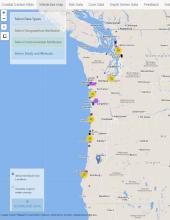
About this project
Tidal wetlands capture and store substantial quantities of carbon. This "blue carbon" is of great interest to those developing regional, national, and global climate change adaptation and mitigation strategies. To better understand the amount of carbon in Pacific Northwest tidal wetlands, the 2016-2019 collaborative research Pacific Northwest Carbon Stocks and Blue Carbon Database Project conducted the region's first comprehensive blue carbon assessment of tidal wetlands and generated a user-friendly database of Pacific Northwest blue carbon data.
About these datasets
The project collected carbon stocks and ecosystem driver data at 34 sites representing the full range of PNW tidal wetland classes (seagrass, low marsh, high marsh, and forested tidal wetlands) and geographically distinct coastal regions (Salish Sea/Puget Sound, Columbia estuary, and outer coast estuaries from Washington to northern California). This included the collection of 50 cm carbon sequestration rate cores at all but eelgrass and pasture sites and the collection of organic matter decomposition data at a subset of project sites.
The dataset description provides more detail about the carbon stock and environmental driver data collected for six related datasets:
- PNW Blue carbon database - study metadata
- PNW Blue carbon database - core level data
- PNW Blue carbon decomposition
- PNW groundwater time series
- PNW channel hydrology time series
- PNW wetland elevation data
Data access
The datasets for this project will be made publicly available through the Smithsonian Environmental Research Center ’s Coastal Carbon Research Coordination Network (CCRCN) Coastal Carbon Atlas. New data will continue to be added to the database on a regular basis. In 2022, project data will also be accessible via a data request form on this page.
For questions about these data, contact:
Craig Cornu, Institute for Applied Ecology, [email protected]
Chris Janousek, Oregon State University, [email protected]